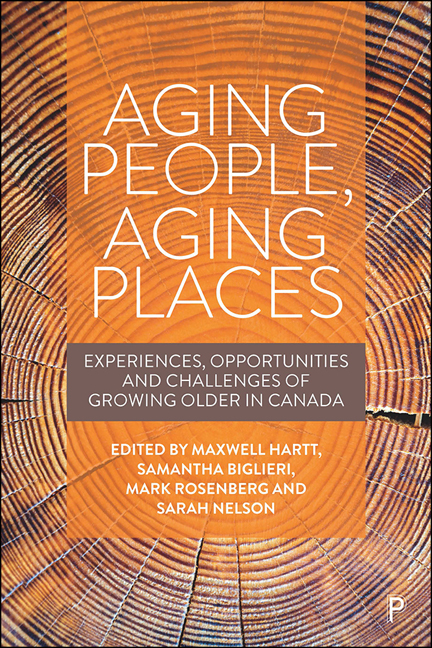80 results
Social Security Policymaking in Costa Rica: A Research Report
-
- Journal:
- Latin American Research Review / Volume 14 / Issue 1 / 1979
- Published online by Cambridge University Press:
- 24 October 2022, pp. 116-133
-
- Article
-
- You have access
- Export citation
Age-Friendly Cities and Older Indigenous People: An Exploratory Study in Prince George, Canada
-
- Journal:
- Canadian Journal on Aging / La Revue canadienne du vieillissement / Volume 41 / Issue 2 / June 2022
- Published online by Cambridge University Press:
- 14 May 2021, pp. 273-282
-
- Article
-
- You have access
- Open access
- HTML
- Export citation
PART IV - Indigenous
-
- Book:
- Aging People, Aging Places
- Published by:
- Bristol University Press
- Published online:
- 18 December 2021
- Print publication:
- 31 March 2021, pp 195-196
-
- Chapter
- Export citation
Index
-
- Book:
- Aging People, Aging Places
- Published by:
- Bristol University Press
- Published online:
- 18 December 2021
- Print publication:
- 31 March 2021, pp 255-264
-
- Chapter
- Export citation
Contents
-
- Book:
- Aging People, Aging Places
- Published by:
- Bristol University Press
- Published online:
- 18 December 2021
- Print publication:
- 31 March 2021, pp iii-iv
-
- Chapter
- Export citation

Aging People, Aging Places
- Experiences, Opportunities and Challenges of Growing Older in Canada
-
- Published by:
- Bristol University Press
- Published online:
- 18 December 2021
- Print publication:
- 31 March 2021
List of figures and tables
-
- Book:
- Aging People, Aging Places
- Published by:
- Bristol University Press
- Published online:
- 18 December 2021
- Print publication:
- 31 March 2021, pp v-vi
-
- Chapter
- Export citation
7 - An age-friendly city? LGBTQ and frail older adults
-
-
- Book:
- Aging People, Aging Places
- Published by:
- Bristol University Press
- Published online:
- 18 December 2021
- Print publication:
- 31 March 2021, pp 89-108
-
- Chapter
- Export citation
PART III - Rural
-
- Book:
- Aging People, Aging Places
- Published by:
- Bristol University Press
- Published online:
- 18 December 2021
- Print publication:
- 31 March 2021, pp 139-140
-
- Chapter
- Export citation
Frontmatter
-
- Book:
- Aging People, Aging Places
- Published by:
- Bristol University Press
- Published online:
- 18 December 2021
- Print publication:
- 31 March 2021, pp i-ii
-
- Chapter
- Export citation
PART II - Suburban
-
- Book:
- Aging People, Aging Places
- Published by:
- Bristol University Press
- Published online:
- 18 December 2021
- Print publication:
- 31 March 2021, pp 79-80
-
- Chapter
- Export citation
Conclusion
-
-
- Book:
- Aging People, Aging Places
- Published by:
- Bristol University Press
- Published online:
- 18 December 2021
- Print publication:
- 31 March 2021, pp 247-254
-
- Chapter
- Export citation
PART I - Urban
-
- Book:
- Aging People, Aging Places
- Published by:
- Bristol University Press
- Published online:
- 18 December 2021
- Print publication:
- 31 March 2021, pp 13-14
-
- Chapter
- Export citation
12 - A profile of the rural and remote older population
-
-
- Book:
- Aging People, Aging Places
- Published by:
- Bristol University Press
- Published online:
- 18 December 2021
- Print publication:
- 31 March 2021, pp 149-164
-
- Chapter
- Export citation
Notes on contributors
-
- Book:
- Aging People, Aging Places
- Published by:
- Bristol University Press
- Published online:
- 18 December 2021
- Print publication:
- 31 March 2021, pp vii-xii
-
- Chapter
- Export citation
Age-Friendly Communities and Cultural Pluralism: Examining Saskatoon’s Chinese-Canadian Social Enclave
-
- Journal:
- Canadian Journal on Aging / La Revue canadienne du vieillissement / Volume 40 / Issue 3 / September 2021
- Published online by Cambridge University Press:
- 19 June 2020, pp. 463-474
-
- Article
-
- You have access
- HTML
- Export citation
Determinants of Overnight Stay in Health Centres and Length of Admission: A Study of Canadian Seniors
-
- Journal:
- Canadian Journal on Aging / La Revue canadienne du vieillissement / Volume 39 / Issue 4 / December 2020
- Published online by Cambridge University Press:
- 24 February 2020, pp. 533-544
-
- Article
-
- You have access
- HTML
- Export citation
Understanding unmet health-care need among older Ghanaians: a gendered analysis
-
- Journal:
- Ageing & Society / Volume 41 / Issue 8 / August 2021
- Published online by Cambridge University Press:
- 28 January 2020, pp. 1748-1769
- Print publication:
- August 2021
-
- Article
- Export citation
Food Insecurity and Aging: A Scoping Study of the Literature
-
- Journal:
- Canadian Journal on Aging / La Revue canadienne du vieillissement / Volume 39 / Issue 4 / December 2020
- Published online by Cambridge University Press:
- 27 January 2020, pp. 662-696
-
- Article
-
- You have access
- HTML
- Export citation
2323 Large patient volume is associated with adverse patient outcomes among those requiring maintenance renal replacement therapy
-
- Journal:
- Journal of Clinical and Translational Science / Volume 2 / Issue S1 / June 2018
- Published online by Cambridge University Press:
- 21 November 2018, p. 37
-
- Article
-
- You have access
- Open access
- Export citation



